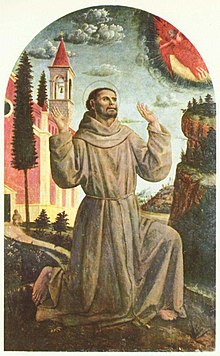Vincenzo Foppa
| Vincenzo Foppa | |
|---|---|

|
|
| Born |
Vincenzo Foppa c. 1427-30 Brescia, Italy |
| Died | c. 1515-16 Brescia, Italy |
| Nationality | Italian |
| Known for | Painting, Architecture |
| Notable work |
Crucifixion Cappella Portinari St. Francis of Assisi receiving the stigmata |
| Movement | Italian Renaissance |
Vincenzo Foppa (c. 1430 – c. 1515) was a Northern-Italian painter, active in a Renaissance style.
He was an elderly contemporary of Leonardo da Vinci. Born at Bagnolo Mella, near Brescia in the Republic of Venice, he settled in Pavia around 1456, serving the dukes of Milan and emerging as one of the most prominent Lombard painters. Foppa returned to Brescia in 1489. His style shows affinities to Andrea del Castagno and Carlo Crivelli. Vasari claimed he had trained in Padua, where he may have been strongly influenced by Mantegna.
During his lifetime, he was highly acclaimed, especially for his skill in perspective and foreshortening. His important works include a fresco in the Brera Gallery of Milan, the Martyrdom of St. Sebastian, the fresco decoration of the Portinari Chapel at the Basilica of Sant'Eustorgio, Milan, and a Crucifixion (1435) now in the Accademia Carrara of Bergamo. Many of his works have been lost.
Foppa was influential in the styles of Vincenzo Civerchio, Girolamo Romanino, and his nephew Paolo Caylina the Younger.
...
Wikipedia
